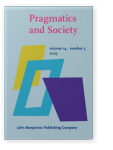Vol. 14:5 (2023) ► pp.753–776
“Trust X, because Y”
A corpus-assisted analysis of trust-related metalanguage labels and trustworthiness cues
Trust is of great importance in modern society, but few studies look at it from a linguistic perspective. This paper explores the discourses of trust based on the data from the BLCU Chinese Corpus (BCC). This paper finds that the communicator’s inner states of trust, suspicion, or distrust could be revealed through various metalanguage labels. This paper also indicates several trustworthiness cues that would help determine whom to trust, including (i) the speaker’s credibility, image, and identity, (ii) the relation between speaker and hearer, and (iii) the information being addressed. Further quantitative analysis demonstrates that credibility plays a vital role in trust building, diminishing, or breaking. Besides, the communicators’ image or relation contributes to their trust-building, but there will be suspicion or distrust if their identity is not as expected. This paper will contribute to the theoretical understanding of trust from a linguistic perspective and an account of how people maintain trust in interpersonal communication.
Article outline
- 1.Introduction
- 2.Literature review
- 3.Methodology
- 3.1Research questions
- 3.2Corpus
- 3.3Corpus analysis
- 4.Findings
- 4.1Trust-related metalanguage labels
- 4.2Trustworthiness cues
- 4.3Co-relationships of trust-related metalanguage labels and trustworthiness cues
- 5.Conclusion
- Acknowledgements
-
References
